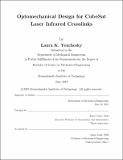Optomechanical design for CubeSat Laser Infrared CrosslinKs
Author(s)
Yenchesky, Laura K.(Laura Katarina)
Download1135062413-MIT.pdf (3.140Mb)
Other Contributors
Massachusetts Institute of Technology. Department of Mechanical Engineering.
Advisor
Kerri Cahoy.
Terms of use
Metadata
Show full item recordAbstract
The CubeSat Laser Infrared CrosslinK (CLICK) mission is a technology demonstrator for a 1.5U intersatellite link laser communications terminal deployed on a pair of 3U CubeSats in Low Earth Orbit (LEO). The narrow transmission full-width half-maximum (FWHM) beamwidth of 14.6 arcseconds coupled with a wider beacon FWHM beamwidth of 0.75 degrees requires precise alignment between and inside both terminals. A two stage pointing, acquisition, and tracking approach is used with a fixed beacon. The coarse pointing stage allocates pointing error to misalignments between the payload aperatures and star tracker aperatures induced by thermoelastic effects. A thermal model, structural model, and statistical analyses are integrated to conclude total thermoelastic induced beacon pointing error with respect to the spacecraft body frame to be less than 9 arcseconds. The ne pointing stage of the approach drives optical mount design with tight tolerances, as well as structural and fastener analysis. Required decentering allowances are as tight as 25.4 [mu]m and 0.1° of allowable rotation from the ideal positions. Kinematic mounts with a translational resolution of ± 15 [mu]m and an angular resolution of ±30 arcsec are implemented at the most sensitive mount locations to enable precision calibration of the payload on the ground. Structural static loading and modal analyses of the CLICK payload under launch loads are conducted to show that the spacecraft bus will not deform sufficiently to cause a beacon pointing loss and that payload elements will not fail under launch loads of 30 G. Margins of safety for static loading in each direction and for fasteners with respect to separation, shear, and tension are greater than 10, above the recommended value of 0. The first resonant frequency of the payload is over 800 Hz, greater than the standard minimum of 100 Hz.
Description
This electronic version was submitted by the student author. The certified thesis is available in the Institute Archives and Special Collections. Thesis: S.B., Massachusetts Institute of Technology, Department of Mechanical Engineering, 2019 Cataloged from student-submitted PDF version of thesis. Includes bibliographical references (pages 54-56).
Date issued
2019Department
Massachusetts Institute of Technology. Department of Mechanical EngineeringPublisher
Massachusetts Institute of Technology
Keywords
Mechanical Engineering.